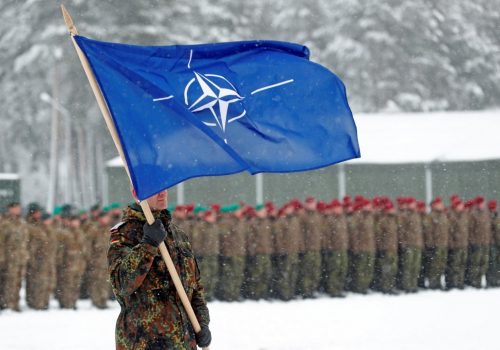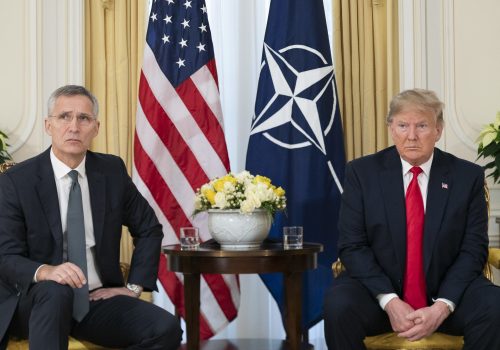October 14, 2020
Open a bank
NATO has a critical capability gap that is hindering its ability to guarantee the security of its member states: its inability to finance defense. If nothing is done, this gap will only grow in the aftermath of the COVID-19 pandemic.
Paying for military forces and deployments has traditionally been the responsibility of individual member states, with NATO ensuring those forces are able to fight together as one. But an alliance built on collective defense must do more than just come to the defense of its members. It must also, as Article 2 of the Washington Treaty holds, “encourage economic collaboration.” As such, NATO should create its own bank.
Ultimately, money underlies any significant military endeavor. The ability to finance military investments and modernization, while paying the huge costs associated with conflict, has been a critical factor in determining success on the battlefield and in shaping the political aftermath. For example, during World War I, the Entente Powers were able to finance their massive war effort through American financial backing from financiers like J.P. Morgan. Similarly, the United States provided vital equipment to the United Kingdom and the Soviet Union through the Lend-Lease program during World War II. These were ad hoc efforts developed on the fly to address a crisis. But NATO is unique because it is not meant to be ad hoc. It is more enduring. As such, it should start thinking now about how to finance itself.
In NATO’s early days, the United States helped undergird the Alliance, both economically through the Marshall Plan, but also by rebuilding Western European militaries, providing the necessary resources to deter the Soviet threat, and building a basing infrastructure to defend Europe. After the Cold War, NATO incorporated former Warsaw Pact members without making any significant investments. The Alliance’s new members came outfitted with aging Eastern Bloc weapons systems and infrastructure. Yet, there was never a comprehensive effort by NATO to rebuild these militaries. Instead, member states have been largely left to modernize their forces on their own. For former Warsaw Pact countries, this entails overhauling entire vehicle and fighter fleets of Soviet/Russian equipment—a hugely expensive, and almost impossible, task for them to undertake on their own.1Poland has notably made an effort to modernize its forces, acquiring F-16s during the 2000s and pursuing a significant military modernization effort, including a $4.6-billion contract for F-35A Lightning II fighter jets signed in January 2020 and an estimated $4.75-billion Patriot missile defense system deal in 2018. However, there is much more to be done in former Warsaw Pact member states, especially those that individually lack the capital to make similar investments. For more, see: Max Bergmann, “To Help NATO Allies Get Off Russian Equipment, the United States Should Revive Defense Lending,” War on the Rocks, February 14, 2018: https://warontherocks.com/2018/02/help-nato-allies-get-off-russian-equipment-united-states-revive-defense-lending/.
Following Russia’s invasion of Ukraine and annexation of Crimea in 2014, the decrepit state of NATO’s eastern members’ military capabilities and obvious infrastructure gaps became a clear problem for the Alliance. NATO, for instance, struggles with the basic task of moving forces to its east. The United States and Europe have sought to rectify this problem by insisting on greater defense spending, increasing joint procurements through NATO’s Smart Defense initiative, increasing US security assistance, and by expanding multilateral initiatives at the European Union (EU) level. But there is much more to do.
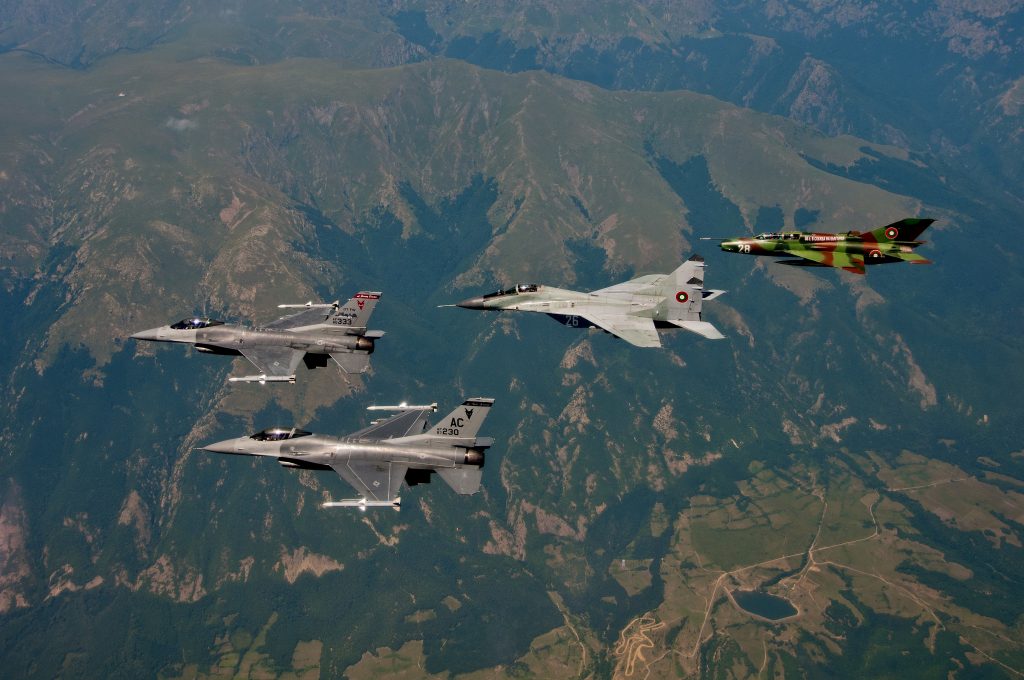
The United States and Europe have sought to rectify this problem by insisting on greater defense spending, increasing joint procurements through NATO’s Smart Defense initiative, increasing US security assistance, and by expanding multilateral initiatives at the European Union (EU) level. But there is much more to do.
Two US Air Force F-16 Fighting Falcons lead a mixed formation including a Bulgarian air force MiG-29 Fulcrum and MiG-21 Fishbed over Bulgaria. (Source: Defense Visual Information Database System)
Adding to the challenge is that NATO’s potential rivals are increasingly using nonmilitary means, such as making strategic acquisitions and investments in European infrastructure, to gain influence and undermine the Alliance. China, through its Belt and Road Initiative and Digital Silk Road, is acquiring strategic infrastructure, much of which has dual-use purposes, especially in the transportation, energy, and telecommunications sectors. Similarly, Russia has established the International Investment Bank (IIB), which, as of 2019, is headquartered in Budapest. Cash-strapped NATO members, lacking adequate financing options, have so far appeared amenable to such investments.
All of these deficiencies point to the need for NATO to create a financial mechanism to invest in its needs. In short, NATO should create its own bank.
There is plenty of precedent for NATO to follow when considering how to establish a multilateral bank. The World Bank, the European Bank for Reconstruction and Development, and the Chinese-led Asian Infrastructure Investment Bank are all examples of multilateral lending institutions that raise capital using a range of debt instruments.
Watch the video
A NATO bank could complement existing multilateral institutions. Allies could make an initial investment that mirrors their existing contributions to organizations like the World Bank and the European Investment Bank, likely in line with their gross domestic products (GDPs). The capital for the bank would likely be accumulated over a multiyear period. The amount of capital the bank would need to hold in liquid reserves would be a small percentage of its overall lending portfolio. A NATO bank could also be set up with guardrails and standards similar to those followed by other lending institutions, including a governing structure and thorough due diligence practices to ensure that funds are allocated and used in line with the bank’s principles.2Project management will be critical to the functioning of the bank, and in bolstering confidence in the institution. Currently, there is no multilateral lending institution specifically dedicated to investments in defense and security. There is, however, the potential that dual-use projects will intersect with efforts funded by the World Bank, European Investment Bank, or other existing mechanisms. In that case, a solid governance and project management structure will be crucial.
NATO should be encouraged by the bond market’s reaction to the EU’s decision this summer to issue debt on the capital markets for the first time. Investors will view EU debt as extremely safe. Achieving a AAA credit rating will be key for NATO to attract a set of institutional investors, much like the European Bank for Reconstruction and Development and the Inter-American Development Bank, and likely, the European Commission’s upcoming credit lines to help member states recover from the COVID-19 pandemic. This would enable inexpensive, low-interest loans to finance critical Alliance efforts.3Using the bank and benefiting from its low interest rates could be conditioned on investing in projects that benefit the Alliance. The bank’s project management teams would need to certify that projects align with NATO’s strategic objectives, and that the money is being used efficiently. Interest rates would likely decrease over time as investors gain confidence in the bank’s ability to repay loans. Once established, the bank would likely become self-sustaining and be able to reinvest its returns, which could offset any costs that NATO’s military and civil budgets struggle to meet. In other words, NATO as an organization could become self-sustaining.
Once established, the bank would likely become self-sustaining and be able to reinvest its returns, which could offset any costs that NATO’s military and civil budgets struggle to meet. In other words, NATO as an organization could become self-sustaining.
A NATO bank could help achieve several aims, and, importantly, allies would retain decision-making power on the mandate and scope of specific investments.
First, a NATO bank could finance defense modernization within the Alliance.4At the outset, the NATO bank would likely be limited to allies, with partners to be potentially included once the bank builds a solid foundation and reputation. It would provide a vehicle for NATO to think beyond arbitrary spending levels and to focus on joint capabilities. Presently, the justified, yet incessant, demands for NATO members to spend two percent of their GDPs on defense may be doing more harm than good. A NATO bank could shift the conversation to focus on financing the Alliance’s pressing needs, as opposed to abstract spending targets that do not efficiently address its capability gaps. The bank could provide low-interest, long-term loans to support defense modernization in Eastern Europe and former Warsaw Pact countries. The only way for these countries to overhaul their militaries is through outside financial assistance. NATO could step in to provide loans at lower rates in a way that fosters joint procurements, which often fail due to financial reasons. All members would be able to borrow at the same rate, allowing many in the Alliance to achieve a better rate through the bank itself than would be possible from another financial institution. This would also create economies of scale and increase interoperability. Having said all that, there is no reason why national deposits from allies into the bank could not contribute toward the two percent target. It could be a creative way to get allies on board with spending more on defense. It may also be politically more tenable for some allies, such as Germany, to pay into a multilateral bank that finances a collective effort rather than arming themselves.
Second, a NATO bank could make strategic investments in infrastructure. This could give NATO an alternative to China’s Belt and Road Initiative. The bank could finance dual-use infrastructure needed to support the Alliance’s military goals, such as improving military mobility. This includes investing in bolstering bridges and roads and the expansion of ports and rail infrastructure to ensure NATO’s forces can move quickly across the Continent. Although military mobility remains a high-profile area for NATO-EU cooperation, the EU is unlikely to fund these efforts at the level it had sought prior to the COVID-19 pandemic. This is where a NATO bank could step in. NATO could also use the bank to invest in partners, such as the Western Balkans or North African states, thereby supporting cooperation and stability.
Third, the bank could invest in emerging technologies. Perhaps NATO could help support joint investments in 5G technology or other advanced technology projects, similar to the role the Defense Advanced Research Projects Agency (DARPA) plays for the US military. Other potential areas of investment could include cyber and space. These would have common value for the Alliance, and could complement efforts already underway through mechanisms like the EU’s Permanent Structured Cooperation (PESCO) and the European Defence Fund. The bank could include a venture capital arm and startup accelerator that would improve the Alliance’s resilience to investments from unideal partners.
Fourth, and perhaps most importantly, a NATO bank would provide readily available funds in case of a crisis or conflict. While the Alliance prepares militarily for potential conflict, it has not prepared for the financial implications of a crisis. Such preparation should not be an afterthought. The unstated assumption has been that the United States, potentially aided by wealthy allies, would pick up the tab. But this should not be assumed. A NATO bank should be part of larger Alliance contingency plans to support members in need and respond to a potential threat.
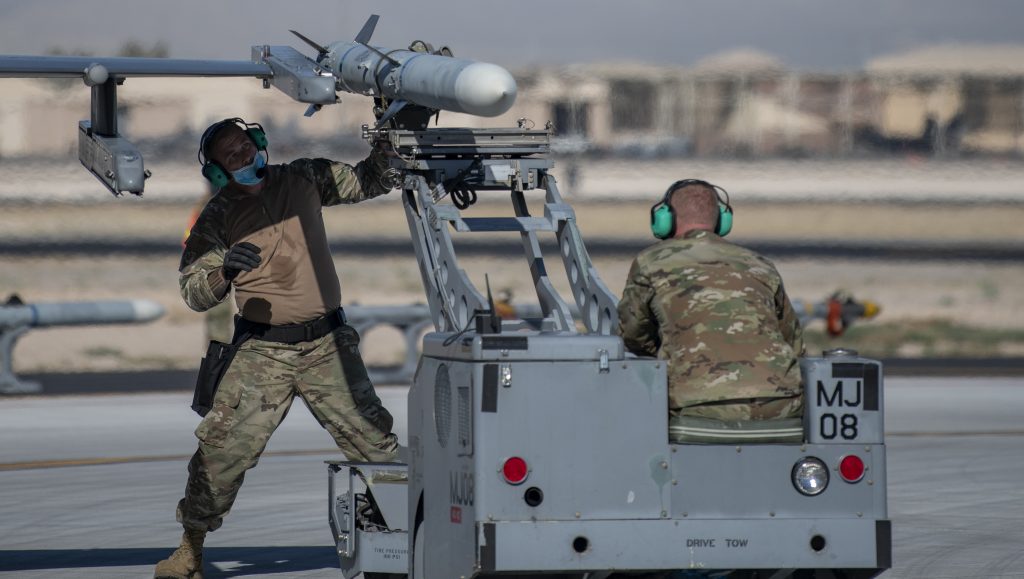
While the Alliance prepares militarily for potential conflict, it has not prepared for the financial implications of a crisis. Such preparation should not be an afterthought.
In 2014, NATO allies established a cooperative program through which allies can acquire air-to-ground precision guided munitions in a cost-effective and flexible way. This is one amongst several initiatives to jointly develop and procure combat systems.
Lastly, a NATO bank could alleviate budgetary pressure caused by the economic fallout from the COVID-19 pandemic. As states look to fund recovery efforts and balance budgets, defense will naturally be on the chopping block. There will, rightfully, be significant pressure from constituents to focus on investing in other sectors like public health, education, and social benefits. A NATO bank could provide counter-cyclical inexpensive loans for joint procurement efforts that create jobs, improve the Alliance’s defense industrial capacity, and bolster NATO’s ability to execute its core mission. A NATO bank could also open lines of credit that enable member states to borrow on more favorable terms in exchange for maintaining defense spending at a certain level. Additionally, states with the financial capacity to capitalize the bank would benefit economically, as their national defense industries would likely be the source of most new defense procurement.
However, a NATO bank would not magically solve all issues facing the Alliance. Some Alliance members may continue to resist making investments, even if offered extremely low borrowing rates, and may need institutional pressure and evidence to incentivize an initial buy-in. Yet others will take advantage, especially if the United States were to shift its diplomatic energy from demanding arbitrary spending targets to supporting specific investments that allow capability gaps to be filled. States, particularly those with smaller budgets, need to be given the financial tools to make these crucial investments. Designing the proper additional incentives will encourage NATO allies to invest. If you build a bank, as history has shown, borrowers will come.
* * *
Max Bergmann is a senior fellow at the Center for American Progress where he focuses on European security and US-Russia policy.
Siena Cicarelli is a research assistant at the Center for American Progress.
Explore the podcast series
Related NATO 20/2020 essays
Related program
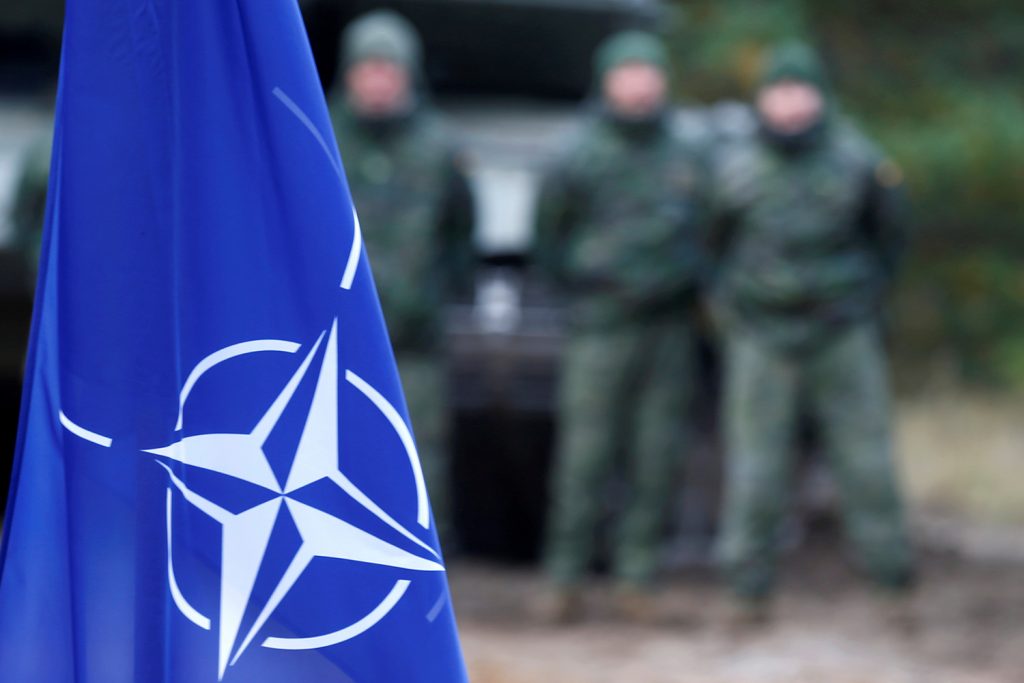
The Transatlantic Security Initiative, in the Scowcroft Center for Strategy and Security, shapes and influences the debate on the greatest security challenges facing the North Atlantic Alliance and its key partners.
Subscribe for events and publications on transatlantic security
Sign up for updates from the Atlantic Council’s Transatlantic Security Initiative, covering the debate on the greatest security challenges facing the North Atlantic Alliance and its key partners.
Image: A five Euro bill. (Source: Unsplash)
